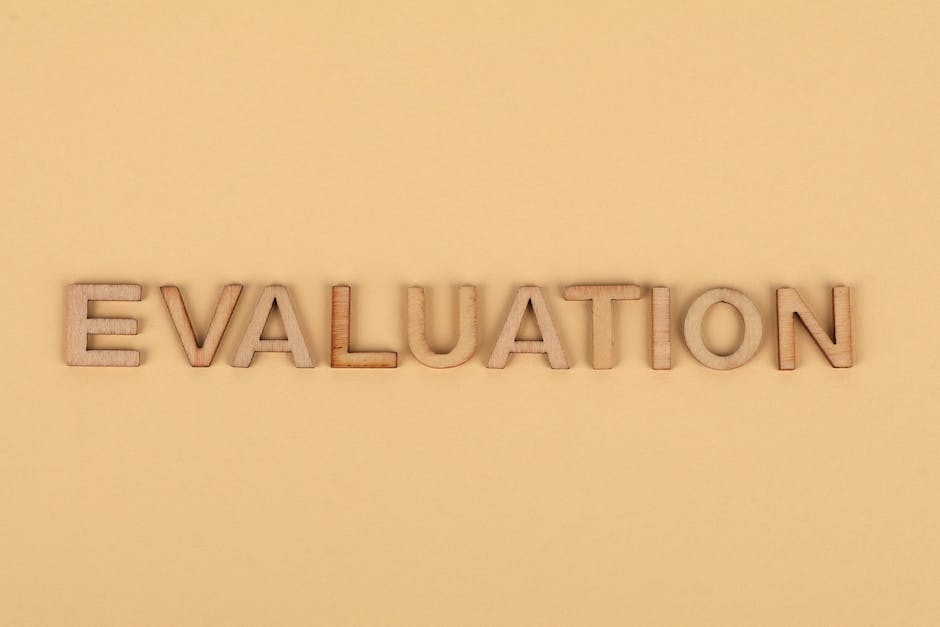Table of Contents
The Ultimate Resource for Effective Interview Evaluation: Comprehensive Form and Easy-to-Follow Instructions.
Introduction
Introduction:
The Complete Guide: Interview Evaluation Form and Step-by-Step Instructions is a comprehensive resource designed to assist interviewers in effectively evaluating candidates during the interview process. This guide provides a detailed evaluation form that covers various aspects of a candidate’s qualifications, skills, and suitability for the position. Additionally, step-by-step instructions are provided to ensure interviewers have a clear understanding of how to use the evaluation form and make informed decisions. By following this guide, interviewers can streamline their evaluation process and make well-informed hiring decisions.
Benefits of Using an Interview Evaluation Form

Benefits of Using an Interview Evaluation Form
In the hiring process, interviews play a crucial role in determining the right candidate for a job. However, conducting interviews can be a challenging task, especially when multiple candidates are involved. To ensure a fair and objective evaluation, many organizations have started using interview evaluation forms. These forms provide a structured approach to assess candidates and help in making informed hiring decisions. In this article, we will explore the benefits of using an interview evaluation form and provide step-by-step instructions on how to create one.
One of the primary benefits of using an interview evaluation form is that it promotes consistency in the evaluation process. When multiple interviewers are involved, it is essential to have a standardized method of assessing candidates. An evaluation form ensures that all interviewers are evaluating candidates based on the same criteria, reducing the chances of bias and ensuring fairness. This consistency also allows for easier comparison of candidates, making it easier to identify the most suitable candidate for the job.
Another advantage of using an interview evaluation form is that it helps interviewers focus on the key competencies required for the job. By outlining the specific skills, qualifications, and attributes desired in a candidate, the evaluation form serves as a reminder for interviewers to assess these aspects during the interview. This ensures that the evaluation is aligned with the job requirements and helps in identifying candidates who possess the necessary qualifications.
Furthermore, an interview evaluation form provides a structured framework for assessing candidates. It typically includes a rating scale or a set of criteria against which candidates are evaluated. This structure helps interviewers organize their thoughts and provides a clear framework for documenting their observations. By having a standardized format, interviewers can easily record their assessments and refer back to them during the decision-making process.
Using an interview evaluation form also facilitates effective communication among the interviewers and the hiring team. With a standardized form, interviewers can easily share their evaluations with each other and discuss the strengths and weaknesses of each candidate. This collaborative approach allows for a more comprehensive assessment and ensures that all perspectives are considered before making a final decision. Additionally, the evaluation form serves as a valuable tool for providing feedback to candidates, helping them understand their performance and areas for improvement.
Now that we have explored the benefits of using an interview evaluation form, let’s discuss how to create one. The first step is to identify the key competencies and qualifications required for the job. This can be done by reviewing the job description and consulting with the hiring team. Once the criteria are established, the next step is to design the evaluation form. It should include a rating scale or a set of criteria against which candidates will be evaluated. Additionally, it should provide space for interviewers to provide comments and observations.
After designing the form, it is essential to train the interviewers on how to use it effectively. This includes explaining the purpose of the form, the rating scale, and the criteria for evaluation. It is also crucial to emphasize the importance of objectivity and fairness in the evaluation process.
In conclusion, using an interview evaluation form offers several benefits in the hiring process. It promotes consistency, focuses on key competencies, provides a structured framework, facilitates effective communication, and allows for feedback to candidates. By following the step-by-step instructions provided, organizations can create an interview evaluation form that enhances the evaluation process and helps in making informed hiring decisions.
How to Create an Effective Interview Evaluation Form
An interview evaluation form is a crucial tool in the hiring process. It allows employers to assess candidates objectively and make informed decisions. Creating an effective interview evaluation form requires careful consideration of the job requirements and the desired skills and qualities in a candidate. In this article, we will provide step-by-step instructions on how to create an interview evaluation form that will help you find the best candidate for the job.
The first step in creating an effective interview evaluation form is to clearly define the job requirements. This involves identifying the key skills, qualifications, and experience necessary for the role. By having a clear understanding of what you are looking for in a candidate, you can create evaluation criteria that are relevant and specific to the job.
Once you have defined the job requirements, the next step is to determine the evaluation criteria. These are the specific qualities and skills that you will assess during the interview. Common evaluation criteria include communication skills, problem-solving abilities, teamwork, and technical expertise. It is important to choose criteria that are directly related to the job and will help you determine if the candidate is a good fit.
After determining the evaluation criteria, you can start designing the interview evaluation form. The form should be structured in a way that allows you to assess each criterion separately. This can be done by creating a rating scale or a checklist for each criterion. A rating scale allows you to assign a numerical value to each criterion, while a checklist allows you to indicate whether the candidate meets or does not meet each criterion.
In addition to the evaluation criteria, it is also important to include open-ended questions in the interview evaluation form. These questions provide an opportunity for the interviewer to gather more detailed information about the candidate’s qualifications and experience. Open-ended questions can also help assess the candidate’s critical thinking skills and problem-solving abilities.
When designing the interview evaluation form, it is important to keep it concise and easy to use. Avoid using jargon or technical terms that may confuse the interviewer. Use clear and simple language that is easy to understand. It is also a good idea to include instructions or guidelines on how to use the form effectively.
Once you have designed the interview evaluation form, it is important to test it before using it in actual interviews. This can be done by conducting mock interviews with colleagues or other hiring managers. This will help identify any flaws or areas for improvement in the form. Make sure to gather feedback from the mock interviewers and make necessary adjustments to the form.
In conclusion, creating an effective interview evaluation form is a crucial step in the hiring process. By clearly defining the job requirements, determining the evaluation criteria, and designing a concise and easy-to-use form, you can ensure that you are assessing candidates objectively and making informed decisions. Remember to test the form before using it in actual interviews and make necessary adjustments based on feedback. With a well-designed interview evaluation form, you can find the best candidate for the job and make a successful hire.
Step-by-Step Instructions for Conducting an Interview Evaluation
Conducting an interview evaluation is a crucial step in the hiring process. It allows employers to assess the qualifications and suitability of candidates for a particular position. To ensure a fair and consistent evaluation, it is essential to have a standardized interview evaluation form and follow a step-by-step process. In this article, we will provide a complete guide on interview evaluation forms and step-by-step instructions for conducting an interview evaluation.
Step 1: Familiarize Yourself with the Interview Evaluation Form
Before conducting an interview evaluation, it is important to familiarize yourself with the interview evaluation form. This form typically includes sections to rate candidates on various criteria such as qualifications, skills, experience, and overall fit for the role. Take the time to understand each section and the rating scale used.
Step 2: Review the Candidate’s Application Materials
To conduct an effective interview evaluation, it is crucial to review the candidate’s application materials beforehand. This includes their resume, cover letter, and any other relevant documents. By doing so, you can gain a better understanding of the candidate’s qualifications and experiences, which will help you evaluate their responses during the interview.
Step 3: Prepare Interview Questions
Develop a set of interview questions that are tailored to the specific role and the qualifications required. These questions should cover both technical skills and behavioral competencies. It is important to ask open-ended questions that allow candidates to provide detailed responses. This will help you assess their problem-solving abilities, communication skills, and cultural fit.
Step 4: Conduct the Interview
During the interview, it is important to create a comfortable and professional environment for the candidate. Begin by introducing yourself and explaining the purpose of the interview. Ask the prepared questions and actively listen to the candidate’s responses. Take notes on their answers, paying attention to their communication skills, knowledge, and overall demeanor.
Step 5: Evaluate the Candidate’s Responses
After the interview, take the time to evaluate the candidate’s responses based on the interview evaluation form. Use the rating scale provided to assess their qualifications, skills, and overall fit for the role. Consider both the content of their responses and the way they presented themselves during the interview. Be objective and avoid any biases that may influence your evaluation.
Step 6: Provide Detailed Feedback
Once you have completed the evaluation, it is important to provide detailed feedback to the hiring team or decision-makers. This feedback should include a summary of the candidate’s strengths and weaknesses, as well as any concerns or reservations you may have. Be specific and provide examples to support your evaluation. This feedback will help the team make an informed decision about the candidate’s suitability for the role.
Step 7: Collaborate with the Hiring Team
Collaboration with the hiring team is crucial in the interview evaluation process. Share your evaluation form and feedback with the team, and discuss the strengths and weaknesses of each candidate. This collaborative approach ensures a fair and comprehensive evaluation, as different perspectives can provide valuable insights.
In conclusion, conducting an interview evaluation requires a systematic approach to ensure fairness and consistency. By following these step-by-step instructions and using a standardized interview evaluation form, employers can effectively assess candidates and make informed hiring decisions. Remember to review the form, prepare questions, conduct the interview, evaluate responses, provide feedback, and collaborate with the hiring team. With these guidelines in place, the interview evaluation process will be streamlined and effective.
Best Practices for Using an Interview Evaluation Form
Best Practices for Using an Interview Evaluation Form
When it comes to conducting interviews, having a structured and organized approach is crucial. One effective tool that can greatly assist in this process is an interview evaluation form. This form allows interviewers to objectively assess candidates based on predetermined criteria, ensuring a fair and consistent evaluation process. In this article, we will explore the best practices for using an interview evaluation form, providing step-by-step instructions to help you make the most of this valuable tool.
First and foremost, it is essential to carefully design your interview evaluation form. Start by identifying the key competencies and skills required for the position you are hiring for. These could include technical expertise, communication skills, problem-solving abilities, and teamwork. Once you have determined the core competencies, create a rating scale that allows interviewers to assess candidates’ proficiency in each area. This scale could range from “poor” to “excellent” or use a numerical system, such as 1 to 5. By clearly defining the criteria and rating scale, you ensure that all interviewers are on the same page and can provide consistent evaluations.
Next, consider the format of your interview evaluation form. While a paper-based form can work, using an electronic form or an applicant tracking system (ATS) can streamline the evaluation process. Electronic forms allow interviewers to easily input their ratings and comments, eliminating the need for manual data entry and reducing the chances of errors. Additionally, using an ATS can provide a centralized platform for storing and accessing evaluation forms, making it easier to compare candidates and track their progress throughout the hiring process.
Before the interview, familiarize yourself with the evaluation form and the criteria you will be assessing. This will help you stay focused during the interview and ensure that you ask relevant questions to gather the necessary information. During the interview, take detailed notes on each candidate’s responses, behaviors, and overall performance. These notes will serve as a reference when completing the evaluation form later.
Once the interview is complete, promptly complete the evaluation form while the details are still fresh in your mind. Be thorough and objective in your assessment, providing specific examples and evidence to support your ratings. Avoid making assumptions or relying solely on your gut feeling. Instead, refer back to the predetermined criteria and rating scale to guide your evaluation.
When multiple interviewers are involved, it is crucial to gather their input and reach a consensus on the candidate’s evaluation. This can be done through a debriefing session or by sharing evaluation forms electronically. By discussing each candidate’s strengths and weaknesses, you can gain different perspectives and ensure a fair and comprehensive evaluation.
Finally, remember that the interview evaluation form is just one piece of the puzzle. It should be used in conjunction with other assessment methods, such as reference checks and skills tests, to make a well-informed hiring decision. Consider the evaluation form as a tool to guide your decision-making process, but not as the sole determinant of a candidate’s suitability for the role.
In conclusion, using an interview evaluation form is a best practice that can greatly enhance the hiring process. By carefully designing the form, using a structured rating scale, and gathering input from multiple interviewers, you can ensure a fair and consistent evaluation of candidates. Remember to stay objective, provide specific examples, and consider the evaluation form as part of a holistic assessment approach. With these best practices in mind, you can confidently evaluate candidates and make informed hiring decisions.
Q&A
1. What is an interview evaluation form?
An interview evaluation form is a document used by employers to assess and rate candidates’ performance during job interviews.
2. What is the purpose of an interview evaluation form?
The purpose of an interview evaluation form is to provide a standardized and structured way for employers to evaluate candidates’ qualifications, skills, and suitability for a specific job position.
3. What should be included in an interview evaluation form?
An interview evaluation form typically includes sections for assessing various aspects of a candidate’s performance, such as their communication skills, technical knowledge, problem-solving abilities, and overall fit for the role. It may also include space for additional comments and recommendations.
4. What are the step-by-step instructions for using an interview evaluation form?
Step 1: Familiarize yourself with the evaluation criteria and rating scale.
Step 2: Observe and assess the candidate’s performance during the interview.
Step 3: Use the evaluation form to rate the candidate’s performance in each relevant category.
Step 4: Provide specific comments or examples to support your ratings.
Step 5: Review and finalize the evaluation form.
Step 6: Share the evaluation form with other interviewers, if applicable.
Step 7: Use the evaluation form as a reference during the candidate selection process.
Conclusion
In conclusion, the Complete Guide: Interview Evaluation Form and Step-by-Step Instructions provides a comprehensive resource for evaluating interviews. It offers a structured approach to assessing candidates and includes a detailed evaluation form that covers various aspects of the interview process. The step-by-step instructions provide guidance on how to effectively evaluate candidates and make informed hiring decisions. Overall, this guide is a valuable tool for organizations looking to streamline their interview evaluation process and select the most suitable candidates for their positions.





